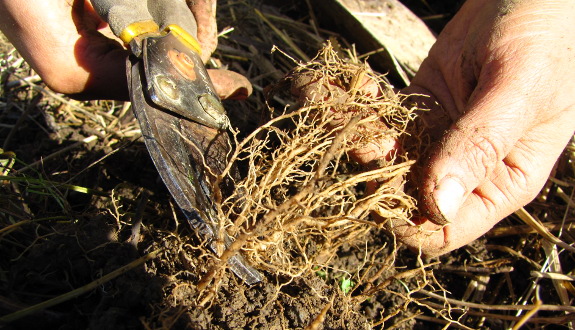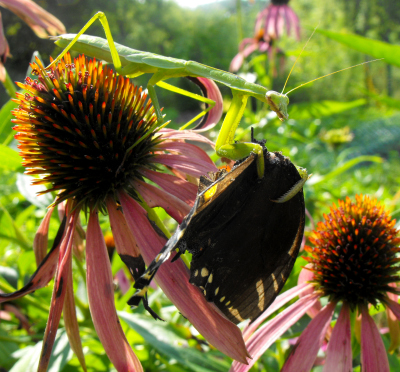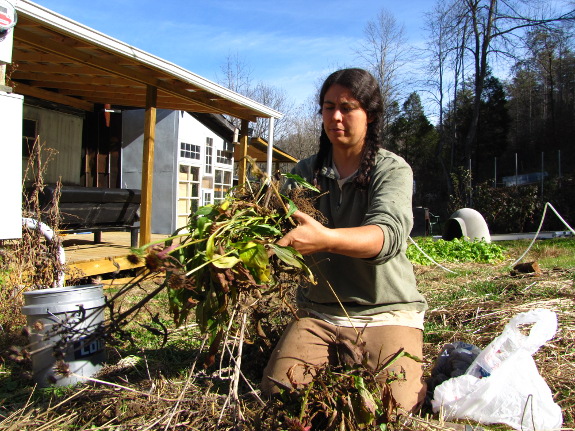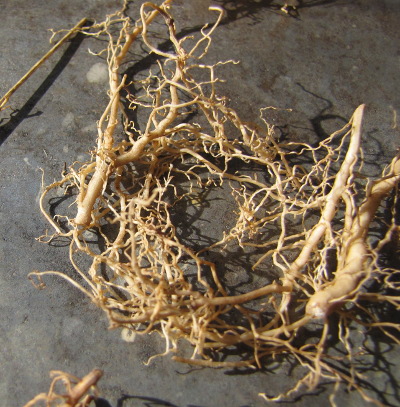
How to harvest echinacea

Echinacea
purpurea (also
known as Purple Coneflower) is one of the few herbs Mark and I
imbibe. If we're going to be travelling or hanging around small
children, we'll take a bit of echinacea the day before, the day of, and
the day after to help our immune systems know  there will germs to fight
off. As a preventative, it's hard to say whether the echinacea
helps, but it certainly doesn't hurt.
there will germs to fight
off. As a preventative, it's hard to say whether the echinacea
helps, but it certainly doesn't hurt.
In the past, we've
bought echinacea from the drug store, but my own little plant (a gift
from a friend when we moved to the farm) is finally old enough to divide and harvest. Although
some people use other parts of the plant, it sounds like you'll get the
most medicinal qualities out of the roots harvested a week or two after
the hard frosts kill back most of the top growth of the plant. In
addition, it's best to wait to harvest until your echinacea plants are
at least two or three years old, and then to only harvest 20% or less
of the roots per year, so you don't kill the plant.

Since it had been six
years since this plant went into the ground, I was able to gently pull
the clump apart into three sections at the same time I harvested the
roots. One section will go back in place, another will move into
the forest garden, and a third will hedge our bets by going to a friend.
 I only cut some of the small
feeder roots since we don't use much echinacea (and since the herb is
only good for about a year). After rinsing them carefully, the
little roots dried in the sun for a few hours to get rid of most of the
wash water. Next, I cut them with scissors into half inch pieces,
which will ensure that the roots dry within two to four days (giving
them no time to mold). The final step will be to store the
echinacea roots in a dark, air-tight container, then to brew up a
decoction by boiling them for 30 to 60 minutes as needed.
I only cut some of the small
feeder roots since we don't use much echinacea (and since the herb is
only good for about a year). After rinsing them carefully, the
little roots dried in the sun for a few hours to get rid of most of the
wash water. Next, I cut them with scissors into half inch pieces,
which will ensure that the roots dry within two to four days (giving
them no time to mold). The final step will be to store the
echinacea roots in a dark, air-tight container, then to brew up a
decoction by boiling them for 30 to 60 minutes as needed.
My plantain
salve has come in
handy, and I realized I use more of these medicinals when I have them
in processed form on the shelf. So hopefully the echinacea will
also hit the spot.
Want more in-depth information? Browse through our books.
Or explore more posts by date or by subject.
About us: Anna Hess and Mark Hamilton spent over a decade living self-sufficiently in the mountains of Virginia before moving north to start over from scratch in the foothills of Ohio. They've experimented with permaculture, no-till gardening, trailersteading, home-based microbusinesses and much more, writing about their adventures in both blogs and books.
Want to be notified when new comments are posted on this page? Click on the RSS button after you add a comment to subscribe to the comment feed, or simply check the box beside "email replies to me" while writing your comment.
